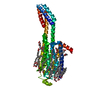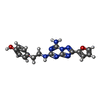+ Open data
Open data
- Basic information
Basic information
| Entry | Database: PDB / ID: 7rm5 | |||||||||||||||
|---|---|---|---|---|---|---|---|---|---|---|---|---|---|---|---|---|
| Title | MicroED structure of the human adenosine receptor at 2.8A | |||||||||||||||
 Components Components | Adenosine receptor A2a/Soluble cytochrome b562 chimera | |||||||||||||||
 Keywords Keywords | MEMBRANE PROTEIN | |||||||||||||||
| Function / homology |  Function and homology information Function and homology informationregulation of norepinephrine secretion / positive regulation of acetylcholine secretion, neurotransmission / negative regulation of alpha-beta T cell activation / positive regulation of circadian sleep/wake cycle, sleep / Adenosine P1 receptors / G protein-coupled adenosine receptor activity / response to purine-containing compound / G protein-coupled adenosine receptor signaling pathway / NGF-independant TRKA activation / Surfactant metabolism ...regulation of norepinephrine secretion / positive regulation of acetylcholine secretion, neurotransmission / negative regulation of alpha-beta T cell activation / positive regulation of circadian sleep/wake cycle, sleep / Adenosine P1 receptors / G protein-coupled adenosine receptor activity / response to purine-containing compound / G protein-coupled adenosine receptor signaling pathway / NGF-independant TRKA activation / Surfactant metabolism / sensory perception / positive regulation of urine volume / synaptic transmission, dopaminergic / type 5 metabotropic glutamate receptor binding / negative regulation of vascular permeability / synaptic transmission, cholinergic / positive regulation of glutamate secretion / intermediate filament / presynaptic active zone / response to caffeine / blood circulation / eating behavior / inhibitory postsynaptic potential / alpha-actinin binding / regulation of calcium ion transport / asymmetric synapse / axolemma / membrane depolarization / phagocytosis / cellular defense response / prepulse inhibition / positive regulation of synaptic transmission, glutamatergic / neuron projection morphogenesis / astrocyte activation / presynaptic modulation of chemical synaptic transmission / response to amphetamine / central nervous system development / positive regulation of long-term synaptic potentiation / positive regulation of synaptic transmission, GABAergic / positive regulation of protein secretion / positive regulation of apoptotic signaling pathway / regulation of mitochondrial membrane potential / synaptic transmission, glutamatergic / excitatory postsynaptic potential / apoptotic signaling pathway / locomotory behavior / electron transport chain / negative regulation of inflammatory response / vasodilation / adenylate cyclase-modulating G protein-coupled receptor signaling pathway / adenylate cyclase-activating G protein-coupled receptor signaling pathway / blood coagulation / cell-cell signaling / presynaptic membrane / G alpha (s) signalling events / phospholipase C-activating G protein-coupled receptor signaling pathway / negative regulation of neuron apoptotic process / postsynaptic membrane / calmodulin binding / electron transfer activity / periplasmic space / positive regulation of ERK1 and ERK2 cascade / iron ion binding / response to xenobiotic stimulus / inflammatory response / negative regulation of cell population proliferation / neuronal cell body / heme binding / apoptotic process / dendrite / lipid binding / regulation of DNA-templated transcription / protein-containing complex binding / glutamatergic synapse / enzyme binding / identical protein binding / membrane / plasma membrane Similarity search - Function | |||||||||||||||
| Biological species |  Homo sapiens (human) Homo sapiens (human) | |||||||||||||||
| Method | ELECTRON CRYSTALLOGRAPHY / electron crystallography /  MOLECULAR REPLACEMENT / cryo EM / Resolution: 2.79 Å MOLECULAR REPLACEMENT / cryo EM / Resolution: 2.79 Å | |||||||||||||||
 Authors Authors | Martynowycz, M.W. / Shiriaeva, A. / Ge, X. / Hattne, J. / Nannenga, B.L. / Cherezov, V. / Gonen, T. | |||||||||||||||
| Funding support |  United States, 4items United States, 4items
| |||||||||||||||
 Citation Citation |  Journal: Proc Natl Acad Sci U S A / Year: 2021 Journal: Proc Natl Acad Sci U S A / Year: 2021Title: MicroED structure of the human adenosine receptor determined from a single nanocrystal in LCP. Authors: Michael W Martynowycz / Anna Shiriaeva / Xuanrui Ge / Johan Hattne / Brent L Nannenga / Vadim Cherezov / Tamir Gonen /  Abstract: G protein-coupled receptors (GPCRs), or seven-transmembrane receptors, are a superfamily of membrane proteins that are critically important to physiological processes in the human body. Determining ...G protein-coupled receptors (GPCRs), or seven-transmembrane receptors, are a superfamily of membrane proteins that are critically important to physiological processes in the human body. Determining high-resolution structures of GPCRs without bound cognate signaling partners, such as a G protein, requires crystallization in lipidic cubic phase (LCP). GPCR crystals grown in LCP are often too small for traditional X-ray crystallography. These microcrystals are ideal for investigation by microcrystal electron diffraction (MicroED), but the gel-like nature of LCP makes traditional approaches to MicroED sample preparation insurmountable. Here, we show that the structure of a human A adenosine receptor can be determined by MicroED after converting the LCP into the sponge phase followed by focused ion-beam milling. We determined the structure of the A adenosine receptor to 2.8-Å resolution and resolved an antagonist in its orthosteric ligand-binding site, as well as four cholesterol molecules bound around the receptor. This study lays the groundwork for future structural studies of lipid-embedded membrane proteins by MicroED using single microcrystals that would be impossible with other crystallographic methods. | |||||||||||||||
| History |
|
- Structure visualization
Structure visualization
| Movie |
 Movie viewer Movie viewer |
|---|---|
| Structure viewer | Molecule:  Molmil Molmil Jmol/JSmol Jmol/JSmol |
- Downloads & links
Downloads & links
- Download
Download
| PDBx/mmCIF format |  7rm5.cif.gz 7rm5.cif.gz | 97.9 KB | Display |  PDBx/mmCIF format PDBx/mmCIF format |
|---|---|---|---|---|
| PDB format |  pdb7rm5.ent.gz pdb7rm5.ent.gz | 68.5 KB | Display |  PDB format PDB format |
| PDBx/mmJSON format |  7rm5.json.gz 7rm5.json.gz | Tree view |  PDBx/mmJSON format PDBx/mmJSON format | |
| Others |  Other downloads Other downloads |
-Validation report
| Summary document |  7rm5_validation.pdf.gz 7rm5_validation.pdf.gz | 1.1 MB | Display |  wwPDB validaton report wwPDB validaton report |
|---|---|---|---|---|
| Full document |  7rm5_full_validation.pdf.gz 7rm5_full_validation.pdf.gz | 1.1 MB | Display | |
| Data in XML |  7rm5_validation.xml.gz 7rm5_validation.xml.gz | 16.9 KB | Display | |
| Data in CIF |  7rm5_validation.cif.gz 7rm5_validation.cif.gz | 24 KB | Display | |
| Arichive directory |  https://data.pdbj.org/pub/pdb/validation_reports/rm/7rm5 https://data.pdbj.org/pub/pdb/validation_reports/rm/7rm5 ftp://data.pdbj.org/pub/pdb/validation_reports/rm/7rm5 ftp://data.pdbj.org/pub/pdb/validation_reports/rm/7rm5 | HTTPS FTP |
-Related structure data
| Related structure data |  24551MC  4eiyS |
|---|---|
| Similar structure data | Similarity search - Function & homology  F&H Search F&H Search |
- Links
Links
- Assembly
Assembly
| Deposited unit | 
| ||||||||||||
|---|---|---|---|---|---|---|---|---|---|---|---|---|---|
| 1 | 
| ||||||||||||
| Unit cell |
|
- Components
Components
| #1: Protein | Mass: 49974.281 Da / Num. of mol.: 1 Source method: isolated from a genetically manipulated source Source: (gene. exp.)  Homo sapiens (human), (gene. exp.) Homo sapiens (human), (gene. exp.)  Gene: ADORA2A, ADORA2, cybC / Production host:  | ||||||||
|---|---|---|---|---|---|---|---|---|---|
| #2: Chemical | ChemComp-ZMA / | ||||||||
| #3: Chemical | ChemComp-CLR / #4: Chemical | ChemComp-NA / | #5: Water | ChemComp-HOH / | Has ligand of interest | N | Has protein modification | Y | |
-Experimental details
-Experiment
| Experiment | Method: ELECTRON CRYSTALLOGRAPHY |
|---|---|
| EM experiment | Aggregation state: 3D ARRAY / 3D reconstruction method: electron crystallography |
- Sample preparation
Sample preparation
| Component | Name: Adenosine receptor A2a/Soluble cytochrome b562 chimera Type: COMPLEX / Entity ID: #1 / Source: RECOMBINANT | ||||||||||||
|---|---|---|---|---|---|---|---|---|---|---|---|---|---|
| Molecular weight | Value: 0.05872 MDa / Experimental value: NO | ||||||||||||
| Source (natural) |
| ||||||||||||
| Source (recombinant) |
| ||||||||||||
| Buffer solution | pH: 5 Details: 25-28% (v/v) PEG 400, 0.04-0.06M sodium thiocyanate, 2% (v/v) 2,5-hexanediol, 100mM sodium citrate, pH 5.0, Lipid Cubic Phase (LCP), temperature 293K | ||||||||||||
| Specimen | Conc.: 10 mg/ml / Embedding applied: NO / Shadowing applied: NO / Staining applied: NO / Vitrification applied: YES | ||||||||||||
| Specimen support | Grid material: COPPER / Grid mesh size: 200 divisions/in. / Grid type: Quantifoil R2/2 | ||||||||||||
| Vitrification | Instrument: LEICA EM GP / Cryogen name: ETHANE / Humidity: 95 % / Chamber temperature: 298 K |
-Data collection
| Experimental equipment |  Model: Titan Krios / Image courtesy: FEI Company |
|---|---|
| Microscopy | Model: FEI TITAN KRIOS |
| Electron gun | Electron source:  FIELD EMISSION GUN / Accelerating voltage: 300 kV / Illumination mode: FLOOD BEAM FIELD EMISSION GUN / Accelerating voltage: 300 kV / Illumination mode: FLOOD BEAM |
| Electron lens | Mode: DIFFRACTION / Nominal defocus max: 0 nm / Nominal defocus min: 0 nm / Cs: 2.7 mm / C2 aperture diameter: 50 µm / Alignment procedure: BASIC |
| Specimen holder | Cryogen: NITROGEN / Specimen holder model: FEI TITAN KRIOS AUTOGRID HOLDER / Temperature (max): 83 K / Temperature (min): 77 K |
| Image recording | Average exposure time: 3 sec. / Electron dose: 0.01 e/Å2 / Film or detector model: FEI CETA (4k x 4k) / Num. of diffraction images: 134 / Num. of grids imaged: 1 |
| Image scans | Sampling size: 28 µm / Width: 2048 / Height: 2048 |
| EM diffraction | Camera length: 1900 mm / Tilt angle list: -40, +40, 0.6 |
| EM diffraction shell | Resolution: 37.91→2.79 Å / Fourier space coverage: 77 % / Multiplicity: 3.7 / Num. of structure factors: 10071 / Phase residual: 30 ° |
| EM diffraction stats | Fourier space coverage: 77 % / High resolution: 2.79 Å / Num. of intensities measured: 37130 / Num. of structure factors: 10071 / Phase error: 30 ° / Phase error rejection criteria: none / Rmerge: 0.299 |
| Diffraction | Serial crystal experiment: N |
| Detector | Detector: CMOS / Date: Sep 11, 2020 |
- Processing
Processing
| Software |
| |||||||||||||||||||||
|---|---|---|---|---|---|---|---|---|---|---|---|---|---|---|---|---|---|---|---|---|---|---|
| EM software |
| |||||||||||||||||||||
| Image processing | Details: CetaD binned by 2 | |||||||||||||||||||||
| EM 3D crystal entity | ∠α: 90 ° / ∠β: 90 ° / ∠γ: 90 ° / A: 40 Å / B: 180.5 Å / C: 139.7 Å / Space group name: C2221 / Space group num: 20 | |||||||||||||||||||||
| CTF correction | Type: NONE | |||||||||||||||||||||
| 3D reconstruction | Resolution: 2.79 Å / Resolution method: DIFFRACTION PATTERN/LAYERLINES / Algorithm: FOURIER SPACE / Symmetry type: 3D CRYSTAL | |||||||||||||||||||||
| Atomic model building | B value: 43 / Protocol: RIGID BODY FIT / Space: RECIPROCAL / Target criteria: Maximum likelihood | |||||||||||||||||||||
| Atomic model building | PDB-ID: 4EIY Pdb chain-ID: A / Accession code: 4EIY / Source name: PDB / Type: experimental model | |||||||||||||||||||||
| Refinement | Method to determine structure:  MOLECULAR REPLACEMENT MOLECULAR REPLACEMENTStarting model: 4EIY Resolution: 2.79→37.91 Å / SU B: 0.48 / Cross valid method: FREE R-VALUE / σ(F): 1.3 / Phase error: 0.3063
| |||||||||||||||||||||
| Solvent computation | Shrinkage radii: 0.9 Å / VDW probe radii: 1.11 Å | |||||||||||||||||||||
| Displacement parameters | Biso mean: 43 Å2 | |||||||||||||||||||||
| LS refinement shell | Resolution: 2.79→3.07 Å
|
 Movie
Movie Controller
Controller



 PDBj
PDBj





















